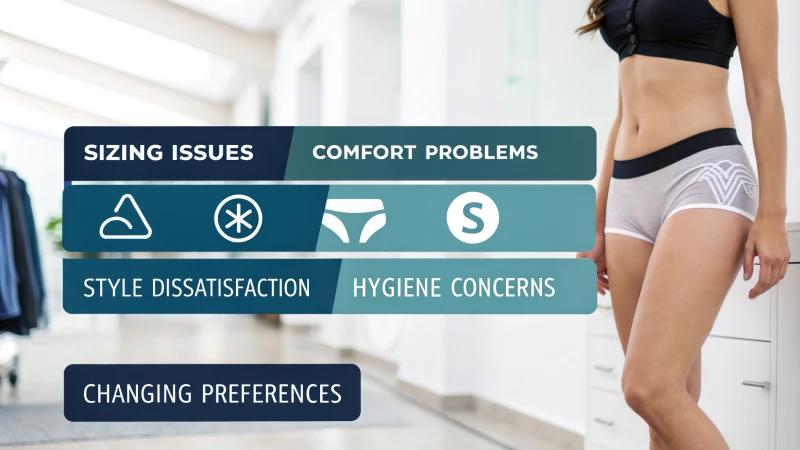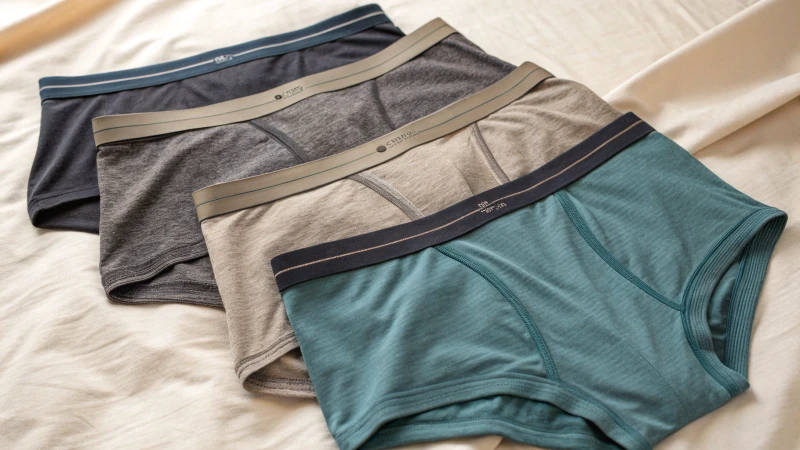
Do you ever ask why people bring back underwear? You are really not the only one! I got curious about this as well, especially after listening to friends talk about their strange return experiences.
People return underwear for different reasons. Incorrect sizing, discomfort and hygiene issues are some of them. Shoppers and brands should know these factors. This helps with better choices and experiences. Better offerings and experiences really matter.
This blog post explores the main reasons why people return underwear. Problems with size and comfort bother many buyers. Knowing these issues really benefits customers and brands. Let's discover these insights, so everyone shops wisely and feels confident when choosing!
Incorrect sizing is a common reason for underwear returns.True
Many customers return underwear due to receiving the wrong size, highlighting the importance of accurate sizing charts.
Hygiene concerns rarely influence underwear return decisions.False
Contrary to popular belief, hygiene issues are a significant factor in why people return underwear.
Why Do People Return Underwear So Often?
Did you ever have the annoying task of returning underwear? Many people have experienced this. Knowing why lots of customers send back these personal items really helps brands understand customer needs. This understanding might help everyone choose better next time.
People return underwear mainly because the size is wrong. Comfort feels off for some, while others dislike the style. Concerns about hygiene play a role too. Preferences change over time. Solving these problems early leads to very happy customers. Happier customers often stay loyal.

Size Issues
One of the primary reasons customers return underwear is due to incorrect sizing. Whether it’s too tight, too loose, or simply not fitting as expected, sizing problems can lead to frustration. This is particularly crucial in intimate apparel, where comfort is paramount.
Finding the perfect fit is crucial for comfort and confidence. Providing detailed size guides and ensuring accurate measurements can help mitigate these issues. Brands should also consider offering a variety of sizes, including plus and petite options, to cater to a broader audience.
| Size Issue | Impact on Customer | Solution |
|---|---|---|
| Too Tight | Discomfort | Offer size charts and fitting advice |
| Too Loose | Lack of support | Include size recommendation tools |
| Wrong Style | Aesthetic concerns | Showcase product images with diverse models |
Comfort and Fabric Quality
Comfort plays a pivotal role in the decision to keep or return underwear. If the fabric is rough or irritating against the skin, customers are likely to seek refunds. Additionally, many consumers are increasingly sensitive to fabric materials due to allergic reactions or skin irritation.
High-quality, breathable materials are vital. Brands must prioritize high-quality materials that provide comfort and breathability. Incorporating customer feedback on fabric preferences can guide future designs and improve retention rates.
Design and Style Mismatches
Sometimes, customers return underwear simply because it doesn’t match their personal style. This could be due to the color, print, or overall design not meeting their expectations compared to what was displayed online.
Returns happen when products don't match our style. Accurate photos and videos help avoid this issue. To combat this issue, brands should provide accurate representations of products through high-resolution images and videos. Clear descriptions about the fit and style can also help manage customer expectations effectively.
Hygiene Concerns
Hygiene is a significant factor when it comes to returning underwear. Due to the intimate nature of these products, many consumers are hesitant to keep items that might have been tried on or feel unclean.
Hygiene in intimate apparel is very important. Brands should emphasize their return policies regarding hygiene to ensure that customers feel confident in their purchases. Encouraging customers to check their sizes before purchasing can also minimize returns.
Changing Preferences
As consumer preferences evolve, items that were once desired may no longer appeal to shoppers. This change can be attributed to trends, lifestyle changes, or even personal growth in fashion choices.
Fashion tastes evolve over time; brands need to stay updated on market trends to produce items that resonate with their audience.
Gift Returns
Finally, returns can often stem from gifts, particularly when the recipient has different preferences in style, size, or comfort level.
Everybody has received a gift that wasn't quite right; offering gift receipts or simple exchange options greatly helps make the experience better for everyone.
For more insights on improving customer satisfaction and reducing returns, check out customer feedback strategies1 and quality assurance in apparel. Understanding these common reasons for returns helps us make better choices and encourages brands to improve their products.
Incorrect sizing is the top reason for returning underwear.True
Many customers return underwear due to issues with fit, such as being too tight or too loose, highlighting the importance of accurate sizing.
Hygiene concerns do not significantly impact underwear returns.False
Given the intimate nature of underwear, hygiene concerns are a major factor for many consumers when deciding to return items.
How Do Retailers Handle Underwear Returns?
Returning underwear might feel awkward, don't you think? Many people have faced this. Stores want to keep things clean and also keep their buyers happy. How do shops handle this tricky issue? Let's find out!
Retailers treat underwear returns in different ways. Most accept returns of unopened items. They enforce strict hygiene rules for opened products. Rules vary a lot. Checking each retailer's guidelines is really important before returning anything. Always check.

Understanding Retailers' Policies on Underwear Returns
Underwear returns can be a tricky topic due to hygiene concerns. Most retailers have established specific policies to address these issues. Generally, retailers like Target2 and Walmart3 may allow returns of unopened items, while open items often face stricter policies.
Common Reasons for Returns:
- Size Issues: Customers may find that the fit is not as expected.
- Comfort: Fabrics may not feel comfortable against the skin.
- Style Preferences: Shoppers might change their minds about style choices.
- Quality Concerns: Defective items or those that don't meet quality expectations often lead to returns.
| Reason for Return | Retailer Handling | Policy Example |
|---|---|---|
| Incorrect Size | Target | Unopened items accepted within 90 days |
| Poor Comfort | Walmart | Returns accepted if unworn |
| Wrong Style | Amazon | May require original packaging |
| Quality Issues | Nordstrom | Full refund for defective items |
Unique Situations in Underwear Returns
There are unique situations when it comes to underwear returns, such as:
- Gifts: Once, I got a pair of fancy boxers not my style! Luckily, many retailers let you return gifts if their rules allow it.
- Unopened Packages: Most stores accept unopened underwear returns, which makes shopping feel safer.
Customer Experiences and Retailer Practices
Customer experiences can vary significantly based on the retailer. Platforms like Reddit4 often feature discussions around personal experiences with underwear returns, revealing inconsistencies across different stores. Some customers report having no issues returning items, while others face challenges.
Online vs In-Store Returns
When it comes to online purchases, the return policies can differ from in-store shopping. Many online retailers, such as Zappos5, offer flexible return policies but may require customers to cover shipping costs for returns.
| Retailer | Online Return Policy | In-Store Return Policy |
|---|---|---|
| Amazon | Free returns within 30 days | Check local store policy |
| Target | Free returns within 90 days | Unopened items accepted |
| Nordstrom | No time limit on returns | Full refund for unworn items |
Exceptions and Special Cases
Some retailers have exceptions in their policies, such as:
- Clearance Items: Often final sales and non-returnable; always check this before buying!
- Hygiene Products: Used underwear usually cannot be returned due to health rules.
- Customized Orders: Personalized items are usually not returnable.
Understanding these rules about underwear returns has been very helpful for me when shopping. Learning each store's guidelines saved me from frustration during returns.
Retailers allow returns of unopened underwear items.True
Most retailers, like Target and Walmart, accept returns of unopened underwear to address hygiene concerns.
Used underwear can typically be returned to retailers.False
Due to health regulations, most retailers do not allow returns of used underwear for hygiene reasons.
How Do Hygiene Concerns Shape Underwear Returns?
Do you ever wonder why taking underwear back to the store feels so tricky? Hygiene worries probably cause most of the trouble. Knowing about these issues really helps avoid feeling annoyed when shopping. Hygiene is very important.
Hygiene issues greatly affect the return of worn underwear because of health dangers like infections and irritation. Retailers have strict rules to keep everyone safe. It is very important for consumers to know these consequences before they buy.

Understanding Hygiene Concerns in Underwear Returns
Hygiene concerns significantly impact the policies surrounding underwear returns. Most retailers enforce strict rules against returning worn underwear due to health regulations. This is rooted in the potential health risks associated with wearing unclean underwear, which can lead to infections and other medical issues.
For instance, many consumers are unaware that wearing dirty underwear can result in bacterial growth, potentially leading to infections6 or skin irritations. These risks compel brands to prioritize customer safety, making it imperative for them to maintain stringent return policies.
The Health Risks of Worn Underwear
Returning worn underwear not only poses a risk to the customer but also to others who may handle these items later. Below is a table summarizing potential health risks associated with wearing dirty underwear:
| Health Risk | Description |
|---|---|
| Bacterial Infections | Bacteria can thrive in moist environments, leading to infections. |
| Fungal Infections | Fungi can grow in damp fabrics, causing discomfort and skin problems. |
| Skin Irritations | Direct contact with unclean fabrics can irritate sensitive skin. |
| Allergic Reactions | Residual allergens on fabric may provoke allergic responses in some users. |
These health concerns underscore the rationale behind policies that disallow returns on worn items, as well as the need for consumers to be vigilant about personal hygiene.
Consumer Rights and Retailer Responsibilities
While consumers may feel entitled to return items that don’t meet their expectations, hygiene regulations often limit these rights in the case of underwear. Retailers have a responsibility to protect public health, which can conflict with consumer satisfaction when preferences change.
Key Considerations for Consumers:
- Understanding Policies: Always read return policies before purchasing underwear.
- Testing Fit and Comfort: Opt for brands that allow returns on unworn items, ensuring you can find the perfect fit.
This dynamic highlights the tension between consumer rights and hygiene concerns within the retail landscape. For more insights on effective shopping practices, consider visiting this guide7.
Alternatives and Solutions for Brands
Brands are increasingly exploring innovative ways to address hygiene concerns while still accommodating customer satisfaction. Here are some strategies:
- Trial Programs: Offering trial periods where customers can wear items with an option to return them if they’re unsatisfied—provided they remain in good hygiene conditions.
- Quality Materials: Using breathable and antimicrobial fabrics that minimize hygiene risks could lead to higher customer satisfaction and fewer returns.
- Clear Communication: Educating customers about proper care and hygiene practices associated with underwear.
Brands that adopt these strategies might see better customer loyalty and reduced return rates, creating a win-win situation for both consumers and retailers.
Hygiene concerns prevent returns of worn underwear.True
Retailers enforce strict return policies on worn underwear due to hygiene risks, such as infections, protecting both consumers and public health.
Consumers can return worn underwear in all situations.False
Hygiene regulations typically prohibit returning worn underwear, limiting consumer rights in this context due to health safety concerns.
How Can Brands Reduce Return Rates for Underwear?
Let's discuss a topic familiar to many꞉ the challenge with underwear returns. I know the feeling when something does not fit properly. The situation frustrates many people. The positive news is companies have the chance to greatly lower these return rates. They achieve this by understanding what customers very much need.
Brands need to lower return rates for underwear. Addressing common sizing issues really helps. Improving product descriptions makes a difference. Clear imagery is very important. Offering flexible return policies is vital. Customer feedback is essential for constant improvement. Repeating this process helps.

Understanding Why Returns Happen
Knowing the reasons for returns is vital. I often sent back underwear due to a few common causes:
- Incorrect Size: Many times I have ordered a size that did not fit right. It feels like a guessing game!
- Comfort Problems: Once, I bought a pair that looked great but felt wrong the moment I wore them. Comfort matters most.
- Wrong Style: Sometimes styles looked good online but did not suit me when they arrived.
- Quality Issues: Receiving a product that seems cheap is disappointing.
- Color or Fabric Disappointment: I once eagerly opened a box and found the color very different from what I imagined.
By addressing these pain points, brands can significantly decrease return rates. Explore more strategies8.
Using Size Guides and Fit Tools
I find comprehensive size guides very helpful. They improve the shopping experience greatly! Here are useful actions:
- Provide Detailed Size Charts: Brands offering measurements for waist, inseam and more really help me find the right fit.
- Fit Predictors: Imagine technology suggesting sizes based on past purchases. This would save a lot of time and frustration!
| Size | Waist Measurement (inches) | Suggested Fit |
|---|---|---|
| S | 28 - 30 | Slim Fit |
| M | 31 - 33 | Regular Fit |
| L | 34 - 36 | Relaxed Fit |
These methods lead to happier customers and fewer returns. Learn how to create effective size guides9.
Enhancing Product Details and Pictures
Clear product details and high-quality images change my online shopping experience. Brands should focus on:
- High-Resolution Images: Showing products from multiple angles and allowing zoom helps me see them better.
- Detailed Descriptions: Knowing about fabric, fit and care tips before purchasing prevents bad surprises.
- User Reviews: I always check feedback from other buyers on fit and comfort - it feels like a conversation before purchasing.
This transparency leads to informed choices and fewer returns. Discover best practices for product imagery10.
Providing Flexible Return Options
Flexible return policies might seem odd but can lower returns over time. Here’s why:
- Building Customer Trust: A safety net for returns encourages me to buy more confidently.
- Less Pressure to Purchase: Feeling secure about returns allows me to try different sizes or styles.
Brands should think about offering:
- Longer return times
- Free return shipping for exchanges
| Policy Type | Description |
|---|---|
| Standard Return | 30 days return policy |
| Exchange Only | Free shipping on exchanges only |
| Risk-Free Trial | Free returns within 60 days |
These policies build better customer experiences and loyalty. Read more about return policy strategies11.
Using Customer Feedback for Betterment
i think brands should always seek customer feedback for improvement. This means:
- Analyzing Return Reasons Often: Understanding why returns happen helps brands adjust and fix issues.
- Asking for Feedback After Purchase: Contacting customers with surveys or questions reveals insights about fit and comfort.
By maintaining an ongoing dialogue with customers, brands can adapt their strategies over time, cutting return rates effectively. Find out how to collect and analyze feedback12.
Incorrect sizing is a major reason for underwear returns.True
Many customers return underwear due to difficulties in finding the right size, leading to dissatisfaction and increased return rates.
High-quality images can lower return rates for underwear.True
Providing clear, high-resolution images helps set realistic expectations, reducing the likelihood of returns due to mismatched expectations.
Conclusion
People return underwear mainly due to sizing issues, discomfort, style mismatches, hygiene concerns, and evolving preferences. Brands can improve offerings by addressing these common return reasons.
Discover valuable insights into consumer behavior and how it impacts your purchasing decisions. ↩
Discover detailed insights into how various retailers manage underwear returns and what you need to know before making a purchase. ↩
Get clarity on exceptions and special cases that might affect your ability to return underwear at various stores. ↩
Learn about unique experiences and challenges faced by customers when returning underwear at different retailers. ↩
Find out how online versus in-store returns differ across popular retailers and what that means for you. ↩
Explore how hygiene regulations shape the return policies of underwear retailers and what this means for consumers. ↩
Discover effective shopping practices for underwear that account for hygiene concerns. ↩
This link provides insights into effective strategies that can enhance your understanding of customer behaviors related to returns. ↩
Learn how proper sizing guides can make a significant difference in reducing returns in your business. ↩
This resource details how product imagery impacts customer satisfaction and returns. ↩
Explore how flexible return policies can paradoxically lower return rates by building trust with customers. ↩
Understanding how customer feedback can drive product improvements is essential for long-term success. ↩






